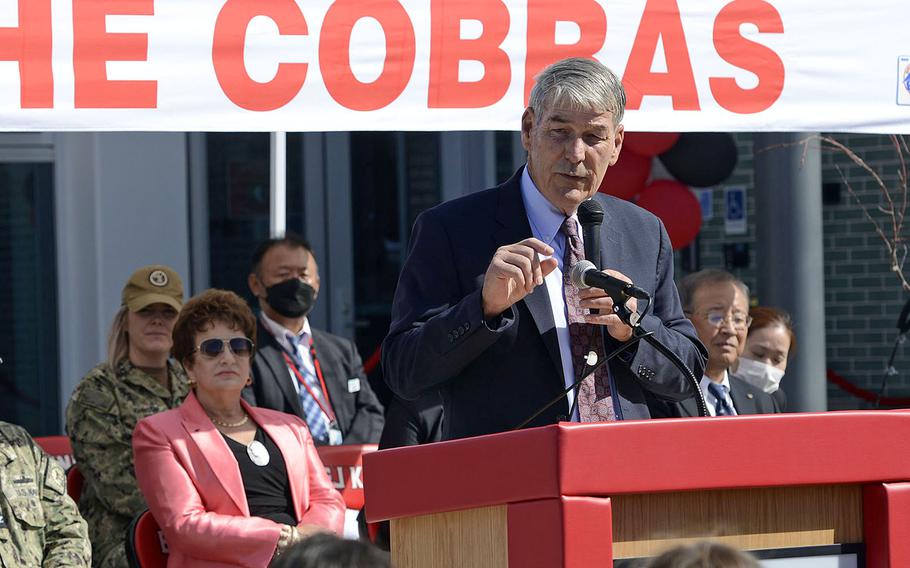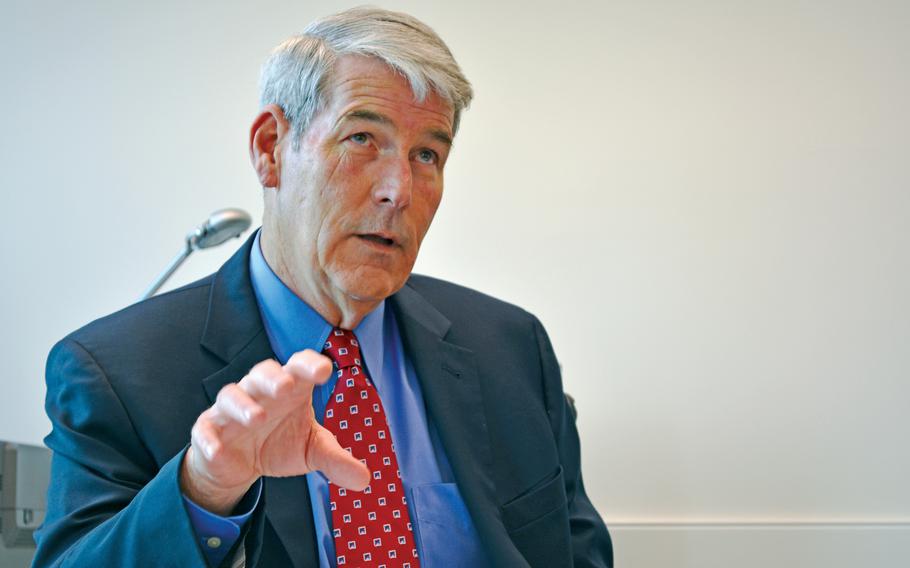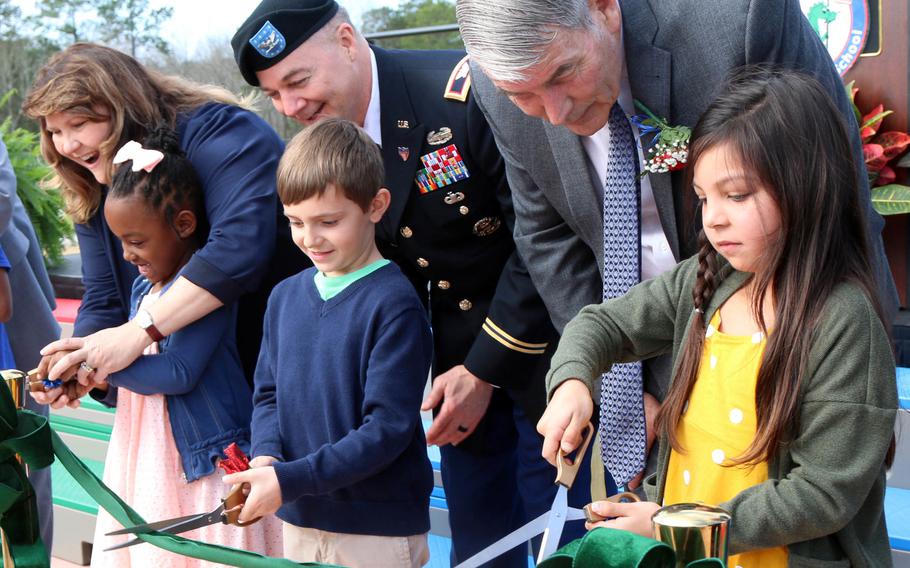
Thomas Brady, director of the Department of Defense Education Activity, speaks during a ceremony for E.J. King Middle and High School at Sasebo Naval Base, Japan, in 2022. Brady is retiring at the end of the school year after heading DODEA since 2014. (Jonathan Snyder/Stars and Stripes)
In 2014, Thomas Brady’s impression of the Pentagon’s network of far-flung schools was one of a system that did a good job, but needed to do better.
Five children and four of 10 grandchildren the retired Army officer shares with his wife, Lisa, went to Department of Defense Education Activity schools, so he was familiar with what a DODEA education entailed when he took over as director.
Ten years later, Brady counts the implementation of college and career ready standards as among the most important initiatives he led at the helm of a system that includes 160 schools, a majority of them overseas.
That tenure, longer than any of the seven directors that came before Brady, ends this month with his retirement.
“I love the organization, I love coming to work every day,” Brady said in an interview recently. “I’m still motivated, but I’m 73, blessed with good health … it’s time to do other things.”

Thomas Brady, seen here in an interview with Stars and Stripes at the beginning of his tenure as Department of Defense Education Activity director, will be stepping down at the end of the school year after heading DODEA since 2014. (Stars and Stripes)
Beth Schiavino-Narvaez, DODEA’s chief academic officer and a career educator, has been named as Brady’s replacement.
Schiavino-Narvaez “will only improve DODEA as an organization going forward,” Brady said.
In his early days as director, Brady saw a need for standards that better prepared students for college and employment. But the curriculum needed uniformity, he said, for students who transferred as their parents moved to a new duty station.
An email he received recently from a teacher in Bavaria underscores that goal, one Brady said he’s been striving for since 2016, when DODEA began a phased, yearslong approach to implementing new standards.
The teacher said one of her students “just came in from Okinawa, and I want to let you know that we’re within two pages of the science notebook” from the previous school, Brady said.
“Ta-da!” Brady said excitedly. “If you’re moving from one place to another, it’s going to be consistent and it’s going to be high quality. That’s part of making a school system better.”
Brady said the standards are paying dividends, as evidenced by DODEA’s rise to the top on the 2022 National Assessment of Educational Progress reading and math scores for fourth and eighth graders.
DODEA’s average scores ranged from 15 to 23 points higher than all national average scores. Given to a sampling of students, the assessment is the only one that provides comparisons from one state to another and with the whole nation. Scores of public schools, meanwhile, saw unprecedented declines in math and significant dips in reading from pre-pandemic levels.
DODEA didn’t see the lapse in learning that affected schools across the nation, Brady said, many of which struggled with remote instruction.
“At the beginning, we went to remote learning in two days,” Brady recalled. “Our teachers were remarkable at that, but it was clear to me that we needed children in schools.”
Adhering to strict mitigation measures resulted in students being in school for most of the COVID-19 pandemic, Brady said.
“Academically, we exceeded my expectations due to the great work of everyone at every level,” he said.
However, the social and emotional effects of the pandemic remain a concern, Brady said.
Many U.S. schools have seen a rise in misconduct, chronic absenteeism, rowdiness outside the classroom and disrespect toward staff, according to the National Center for Education Statistics.
In DODEA, “I don’t see it displayed in misbehavior,” Brady said, “but certainly it is there.”
Schools have added measures to give students who are feeling distressed an opportunity to express that and get support the same day, Brady said.
But in a letter in February to the U.S. House and Senate armed services committees, the Federal Education Association, the union representing DODEA teachers, called for the agency to add school-level mental health specialists.
A Government Accountability Office report, also released in February, suggested that some DODEA students may not be getting needed mental health counseling. About one in five students are ineligible for military support services because their parents are Defense Department civilians.
Brady said mental health care is “a shared responsibility” between the schools, the installation and the medical commands.
“I think we need to continue working with the services to get more specific mental health assets into the schools,” he said, citing the example of Military Family and Life counselors, who offer their support to DODEA schools.
Also in its letter to Congress, the FEA called for DODEA to administer fewer standardized tests and to maintain student-to-teacher ratios of 18:1 for grades K-3 and 24:1 for grades 3-12 until 2030.
“I don’t believe in the major premise that we’re overtesting,” Brady said, in reference to a 2023 GAO report that found DODEA students from K-12 spent an average of eight more days on standardized tests compared to students in nine selected public school districts.

Department of Defense Education Activity director Thomas Brady, right, helps open the new Pierce Terrace Elementary School at Fort Jackson, S.C., Feb. 12, 2020. Brady is retiring at the end of the school year after heading DODEA since 2014. (Jackie Pennoyer/U.S. Army)
Also during Brady’s tenure, “21st century schools” became DODEA buzzwords.
With more than $3 billion in funding from Congress since 2010, DODEA is replacing outdated schools with facilities that feature more open classrooms, and emphasize collaboration and the use of technology.
The transition hasn’t been seamless, Brady said. In some locations, there’s been pushback from parents and some teachers needed better preparation, he said.
“I don’t see any glaring problems,” he said, “but upon reflection, I think we could have done a better job explaining it, because once parents understand and they see it in action and they talk to their children, it’s a remarkable preparation for the next steps.”
Meanwhile, Brady is leaving as DODEA begins rolling out universal prekindergarten. A total of 80 locations are expected to welcome about 4,900 four-year-olds this fall, he said. About 6,000 students are expected to participate when all installations have space available, he said.
DODEA is adding teachers and educational aides for the program, an effort that goes with an improved hiring process, Brady said.
“We’ve seen great success with that,” he said. “We’ve changed a number of policies of how we certify teachers to increase the talent pool … with the aim of trying to improve each one of our schools.
“The work is never done,” he said.